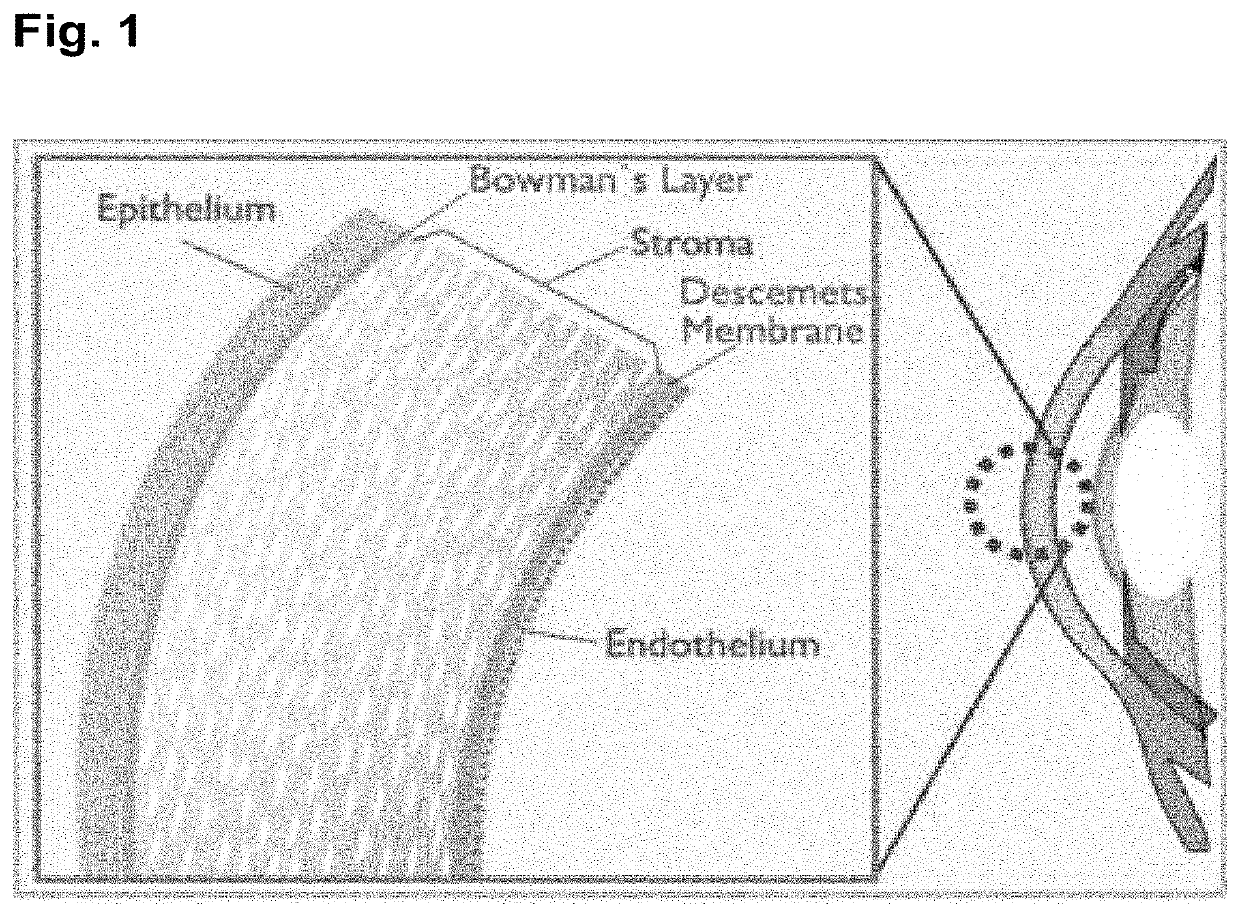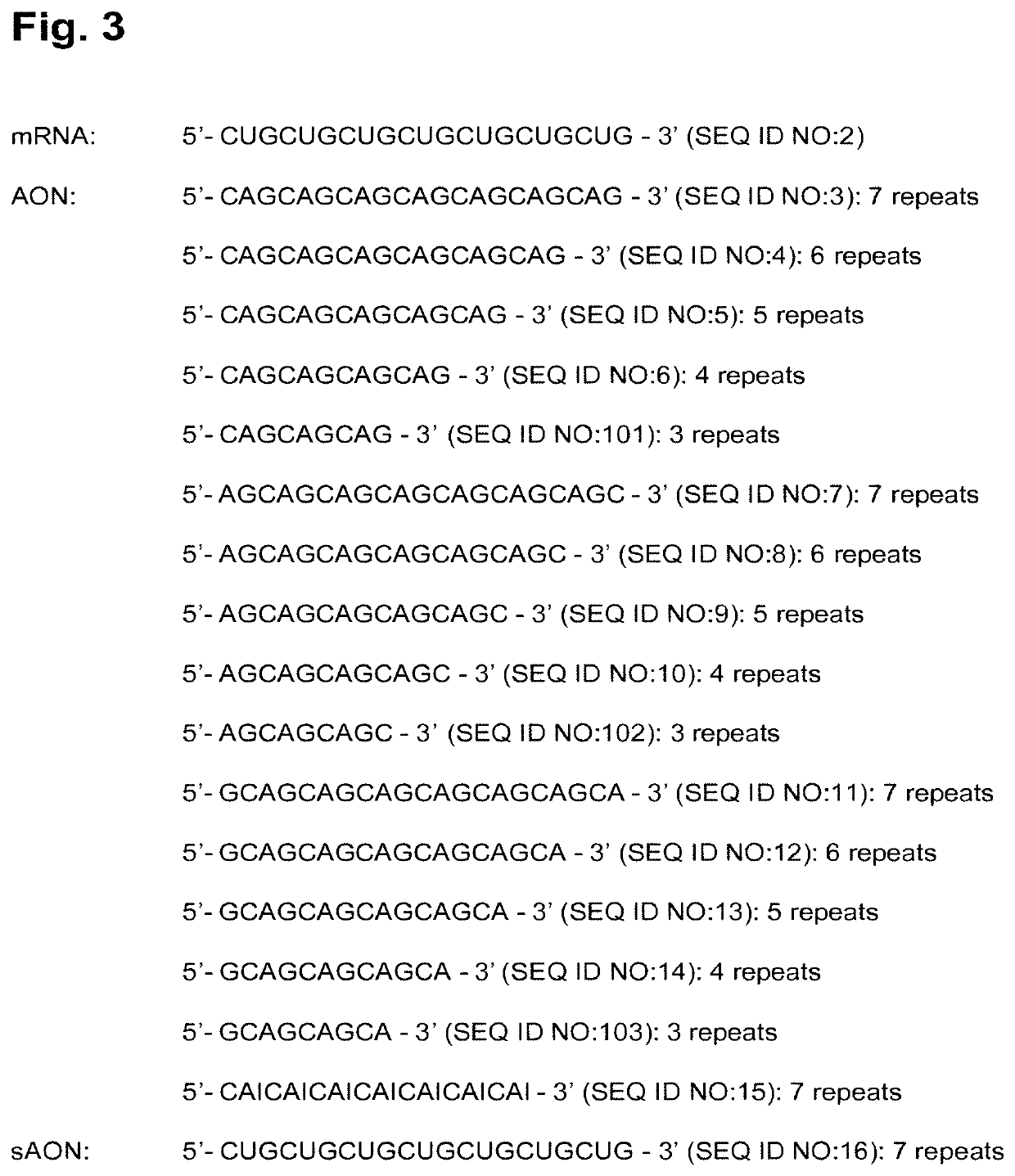Use of single-stranded antisense oligonucleotide in prevention or treatment of genetic diseases involving a trinucleotide repeat expansion
a technology of antisense oligonucleotide and single-stranded antisense, which is applied in the field of medicine, can solve the problems of fecd not being treated with other treatments, affecting the effect of fecd, and affecting the effect of fecd, and achieving the effect of preventing and treating genetic disorders
- Summary
- Abstract
- Description
- Claims
- Application Information
AI Technical Summary
Benefits of technology
Problems solved by technology
Method used
Image
Examples
example 1
ic Approach to Treating FECD Resulting from the Presence of TCF4 TNR Greater than 50 Repeats in Length
[0055]By using anti-sense oligonucleotides (AONs) directed at the expanded CUG TNRs in TCF4, specific sequence binding is achieved, such that this results in reducing the ability of such sequences to sequester RNA processing factors such as MBNL1. The binding of the RNA may additionally result in its degradation due to release from nuclear foci and increased exposure to the lariat debranching enzyme and / or RNases, thus further reducing the cellular pool of repeat-containing RNA that can sequester RNA processing factors. In FECD, the sequestration of MBNL1 leads to toxic RNA foci and aberrant splicing patterns of other RNAs. Targeting 5′-(CUG)n-3′ TNRs in TCF4 derived introns takes place by using AONs with complementary sequences formed either through canonical Watson-Crick base-pairs: 5′-(CAG)m-3′, or through wobble base-pairs, such as 5′-(CAI)m-3′, 5′-(CGG)m-3′, 5′-(CGI)m-3′, 5′-(C...
example 2
the Corneal Endothelial Cell Layer Using Therapeutic Oligonucleotides
[0060]To investigate whether oligonucleotides could enter the corneal endothelium, ten Female Dutch Belted Rabbits were given a single intravitreal administration into both eyes of Cy-5-labelled oligonucleotide (with sequence unrelated to the present invention) utilizing 2′-O-methyl modifications at a single dose of 0.6 mg in 30 μl of PBS at a concentration of 20 mg / ml. Two rabbits were sacrificed at each time-point (6, 24, 48, 72 and 168 hour following intravitreal injection) by an intravenous injection of sodium pentobarbitone and exsanguination. Eyes were subsequently removed and placed into modified Davidson's fluid for fixation. Histological slides were then prepared and stained with Hematoxylin and eosin and then examined on a fluorescent microscope to specifically note structures within the eye that were associated with increased fluorescence which would reflect accumulation of labelled oligonucleotide (FIG....
example 3
geted Therapeutic Oligonucleotide Reduces RNA Foci in FECD CEC
[0062]Predicted therapeutic oligonucleotide comprising a repeated CAG sequence with seven repeats ((CAG)7) was also shown to reduce RNA foci in human corneal endothelial cells derived from an FECD patient with a heterozygous expansion of greater than 40 CUG repeats. The allelic CUG TNR repeats were found to be 12 and 52 in the patient's TCF4 gene. Corneal endothelial cells were derived from this patient using methods known in the art (Peh et al. 2013 BMC Res Notes 6:176; Peh et al. 2015 Sci Rep 5:9167), and the effect of reducing RNA foci in these cells was investigated upon transfecting (CAG)7 into the in vitro held cells. Therapeutic oligonucleotide was used at a concentration of 200 nM and transfected with Dharmafect (0.5 ul per well as per manufacturer's instructions) for 24 hrs. Then, cells were fixed and subjected to FISH with a Cy3-labelled (CAG)7 oligonucleotide probe (performed as noted in Example 1) and viewed o...
PUM
 Login to View More
Login to View More Abstract
Description
Claims
Application Information
 Login to View More
Login to View More - R&D
- Intellectual Property
- Life Sciences
- Materials
- Tech Scout
- Unparalleled Data Quality
- Higher Quality Content
- 60% Fewer Hallucinations
Browse by: Latest US Patents, China's latest patents, Technical Efficacy Thesaurus, Application Domain, Technology Topic, Popular Technical Reports.
© 2025 PatSnap. All rights reserved.Legal|Privacy policy|Modern Slavery Act Transparency Statement|Sitemap|About US| Contact US: help@patsnap.com



